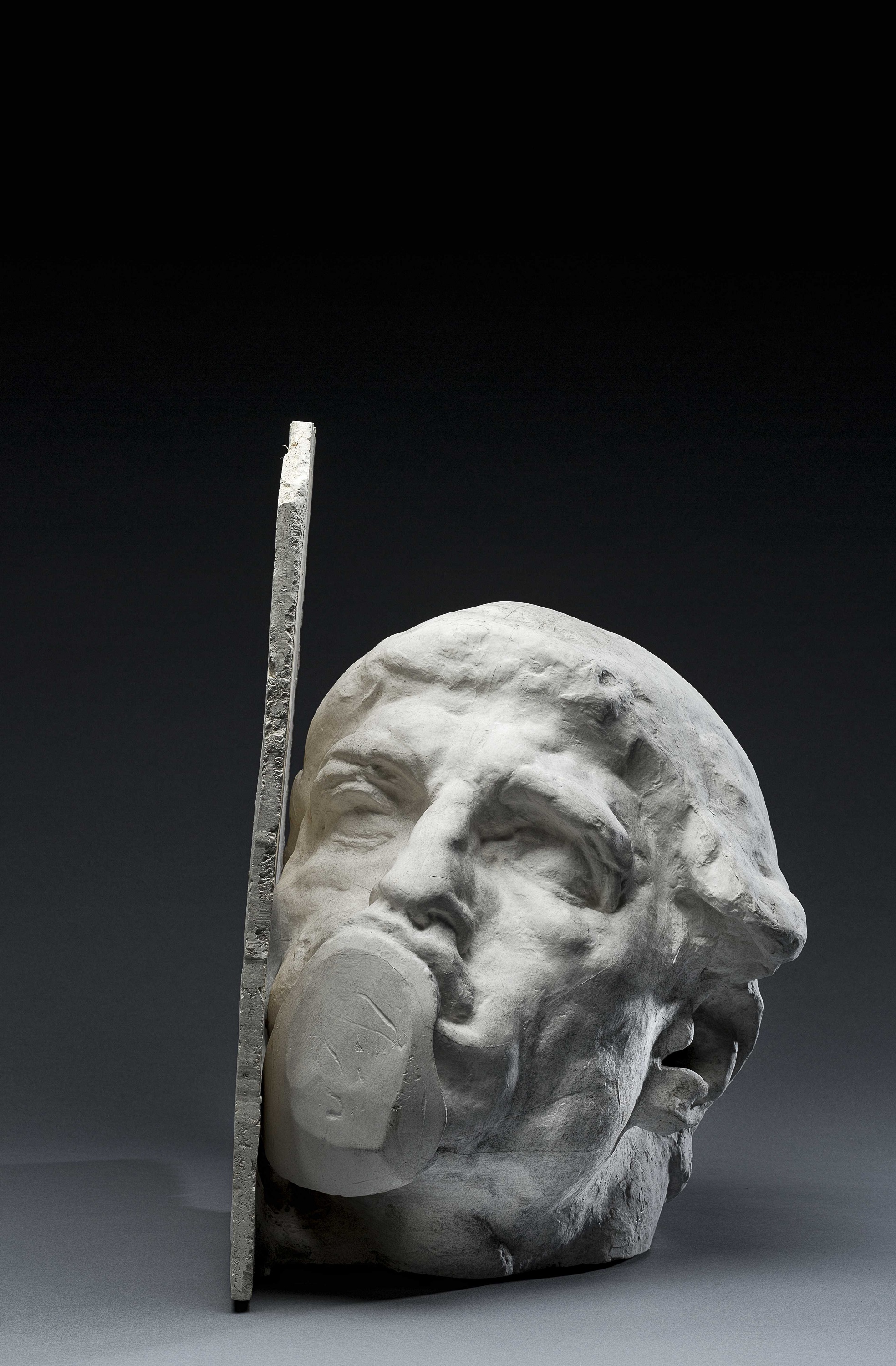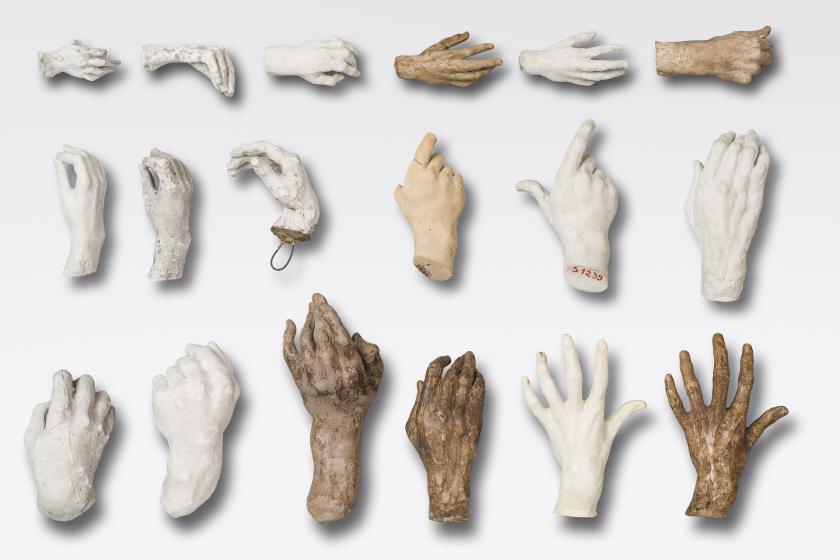Undoubtedly the strangest thing in this exhibition dedicated to Rodin’s works in plaster is a rendition of Balzac’s dressing gown, visibly hollow, but filled out nevertheless by the ghostly contours of an ample male form. Not surprisingly, the phantom dressing gown is sometimes given as evidence of Rodin’s modernist credentials – were it not 39 years too early, it would surely have qualified for the International Surrealist Exhibition of 1936.
The question of Rodin’s modernist intentions is the central one posed by this exceptionally beautiful show, which is also, by Tate standards, refreshingly concise. Its focus is a large central gallery inspired by Rodin’s 1900 exhibition at the Place de l’Alma in Paris, in which he arranged plaster casts of his sculptures in a specially constructed pavilion, evoking the experience of walking through his studio.
 Figures are repeated at different scales, legs are cut off and attached to a different torso, features are distorted, exaggerated or lost entirely in the transition from hand-sized to colossal. The decapitated head of The Thinker is mounted on a slab (pictured right), while a cast of his foot verges on the monstrous, its enormous big toe suddenly conspicuous at this scale. Another of Rodin’s most famous sculptures, The Walking Man, 1907, is a composite of two bodies, the weathered appearance of the torso contrasting with the smooth legs attached at mid thigh. The visual satisfaction that comes from the repetition of forms, echoed and amplified in enlargements, copies and assemblages is intensely experienced in this gallery, and elucidates for the viewer just how intoxicating and creatively fertile they were for Rodin himself.
Figures are repeated at different scales, legs are cut off and attached to a different torso, features are distorted, exaggerated or lost entirely in the transition from hand-sized to colossal. The decapitated head of The Thinker is mounted on a slab (pictured right), while a cast of his foot verges on the monstrous, its enormous big toe suddenly conspicuous at this scale. Another of Rodin’s most famous sculptures, The Walking Man, 1907, is a composite of two bodies, the weathered appearance of the torso contrasting with the smooth legs attached at mid thigh. The visual satisfaction that comes from the repetition of forms, echoed and amplified in enlargements, copies and assemblages is intensely experienced in this gallery, and elucidates for the viewer just how intoxicating and creatively fertile they were for Rodin himself.
Looking at them now, Rodin’s assemblies of body parts seem indisputably modern. At the same time they offer an echo of classical practice, where the ideal body is constructed through the selection of body parts. Rodin abandoned the notion of ideal beauty, a decision symbolised by the opening work here, The Age of Bronze, 1877, which at its first outing critics refused to believe hadn’t been produced by casting direct from the model. Even so, he was, as the British Museum’s 2018 exhibition Rodin and the Art of Ancient Greece showed, still an artist who believed that he was carrying the flame of an ancient and esteemed tradition.
Plaster casts allowed Rodin to make a permanent copy of a clay borzetto, which could then be remodelled with fresh clay, or cut up and reassembled anew. His habit of modelling and then taking multiple casts of individual features, to be used as the need arose, may have the feel of collages, and even readymades, but it still drew on the Renaissance tradition of artists’ pattern books filled with stock images to be incorporated into multiple works (main picture).
It was Rodin’s technique, which changed dramatically after the hostile reception for The Age of Bronze, that was so new. For the Monument to Balzac, he modelled the figure in layers, creating first a nude figure, upon which he placed draperies, in a dramatic departure from traditional practice in which a sculptor would model the complete, clothed form. The effects of this approach were profound, and the Monument to Balzac, with its draperies so solid a part of the composition, reflecting light in great sections rather than playing off small folds and impressions in the sculpture’s surface, betrays little of the flesh and blood beneath, creating instead an abstracted form that transcends the human figure.
Edward Steichen’s photographs of the Monument leave little doubt that for Rodin, the peculiar visual effects that could be achieved through well-aimed light, were both desirable and fascinating. The artist’s friendship with Steichen is well documented, but Rodin worked with several photographers, whose pictures served to stimulate and resolve ideas.
A selection of photographs by Eugène Druet on display here present Rodin’s casts of truncated body parts as abstracted, protean forms. Hands take on human, or animal shape, or appear rocklike, in photographs that make the case for Rodin’s surrealist mindset far more persuasively than anything else here.
Studies of the Japanese dancer and actor Ohta Hisa are a notable highlight, as is a plaster cast of The Burghers of Calais, 1889. A small section dedicated to the sculptor Camille Claudel, who was both Rodin’s assistant and lover, is an important acknowledgement of her contribution to his work.









![SEX MONEY RACE RELIGION [2016] by Gilbert and George. Installation shot of Gilbert & George 21ST CENTURY PICTURES Hayward Gallery](/sites/default/files/styles/thumbnail_125_x_125_/public/mastimages/Gilbert%20%26%20George_%2021ST%20CENTURY%20PICTURES.%20SEX%20MONEY%20RACE%20RELIGION%20%5B2016%5D.%20Photo_%20Mark%20Blower.%20Courtesy%20of%20the%20Gilbert%20%26%20George%20and%20the%20Hayward%20Gallery._0.jpg?itok=3oW-Y84i)





Add comment